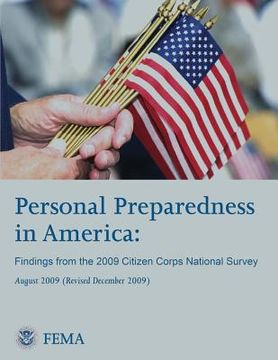Personal Preparedness in America: Findings from the 2009 Citizen Corps National Survey (in English)
Synopsis "Personal Preparedness in America: Findings from the 2009 Citizen Corps National Survey (in English)"
Disaster preparedness became a renewed priority for our Nation as a direct response to the devastation of the terrorist attacks of September 11, 2001. Following the tragedies of that day, government at all levels has embedded stronger collaboration with nongovernmental civic and private sector organizations and the general public in policies and practices. The Citizen Corps grassroots model of community preparedness has spread across the country, and Americans have been asked to become fully aware, trained, and practiced on how to respond to potential threats and hazards. To evaluate the Nation's progress on personal preparedness, the Federal Emergency Management Agency's (FEMA's) Community Preparedness Division conducts Citizen Corps National Surveys to measure the public's knowledge, attitudes, and behaviors relative to preparing for a range of hazards. This report provides a summary of the findings from the 2009 Citizen Corps National Survey. The research objectives and survey questions for the Citizen Corps National Survey were developed based on previous research, preparedness modeling, and policy and guidance from the Department of Homeland Security (DHS). In 2003, Citizen Corps conducted a national survey to provide baseline data on individual preparedness for disasters. In 2007, the Citizen Corps National Survey was designed to incorporate additional areas of examination and to refine the questioning, while retaining several specific questions from the 2003 survey to provide trend data. The 2009 Citizen Corps National Survey includes several more small refinements. Comparisons between the findings from the 2003, 2007, and 2009 surveys are noted throughout the report. FEMA's Community Preparedness Division publishes the Citizen Preparedness Review to highlight specific areas of research regarding community preparedness and to summarize research findings from multiple sources. To assess the research landscape on preparedness, Citizen Corps has developed and maintains the Citizen Preparedness Surveys Database of surveys on personal and business preparedness conducted in the United States since September 11, 2001. As of August 2009, the database contains 102 surveys on individual preparedness, 29 surveys on business, and 11 surveys on school preparedness. Analyzing research from this wide variety of sources allows larger preparedness trends and research gaps to be identified. Citizen Preparedness Review Issue 3, Patterns in Current Research and Future Research Opportunities (published summer 2006), made several recommendations for future research that were taken into consideration in the development of the Citizen Corps National Survey implemented in 2007 and 2009. These recommendations included: More fully explore participants' knowledge of the correct preparedness measures and appropriate responses for different types of hazards; Investigate a more comprehensive range of knowledge, supplies, and skills related to disaster preparedness, such as knowledge of warning systems, evacuation routes, and training for specific skills; More fully explore motivational barriers to preparedness, such as the degree of uncertainty about ability to perform recommended measures or perceptions that recommended measures will not make a difference in disaster situations; Investigate demographic and contextual characteristics as they relate to preparedness including: prior experience with disasters, disability/ability factors, and community engagement; Examine individuals' preparedness in multiple locations in addition to their homes, such as the school, workplace, and community. An important finding from the Citizen Preparedness Surveys Database is that perceived preparedness can be very different from the specific preparedness measures taken. In nearly all cases, these surveys substantiate that the proportion of those who have taken appropriate preparedness measures is much lower than those that indicate that they are prepared.

